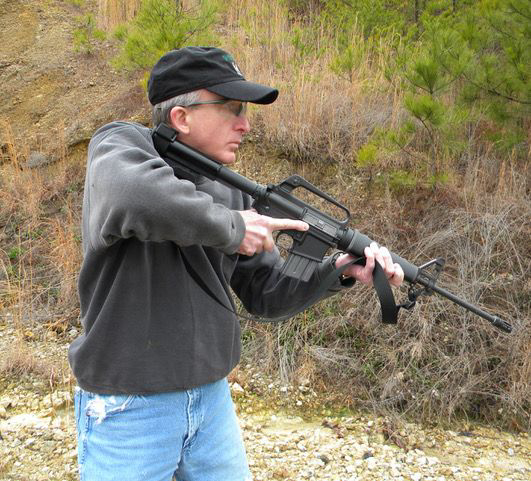
A “ready” position when using firearms means you’re prepared to fire if necessary. Transitioning from “ready” to sights on target should occur as efficiently as possible. But until then, the muzzle shouldn’t be covering anything that you haven’t decided to shoot. This includes any possible threat(s). A proper ready position is with sights off target and trigger finger off the trigger and clear of the trigger guard.
You’re facing a potential threat; the gun is already in hand. It’s not yet time to fire. The arms, hands and weapon – both pistol or long gun - are positioned low enough you can see the threat’s feet. This ensures Safety Rule II is still in effect: Never point the muzzle at anything you’re not willing or ready to shoot.
A ready position that’s too high is unsafe, for a variety of reasons. If the arms, hands and weapon are too high they’ll block you from seeing what’s important. You watch the threat’s hands, determining if they’re armed, and if so with what type of weapon. I teach students to watch the threat’s feet, too. A person’s feet will tell you what they’re thinking about doing, often before they’re even consciously aware of what they’re planning. Their feet tell you if they’re anxious or nervous. They’ll reposition the feet prior to running, or as they prepare to launch an attack.
When working around corners, or the side of cover, the weapon is positioned low enough that you can see the bottom apex of the corner. This allows you to see anyone that’s coming ‘round the corner. It allows you to see part of someone as you slice the pie before they see you. If it’s necessary to shoot, you snap the sights up onto the target. All things being equal, I’ll engage the pelvis first. It’s the first target area of the body you reach when coming up from low ready, and it takes away their mobility.
Anytime you place the finger on the trigger too soon it makes you unsafe -- period. It increases the probability of negligent discharges, and/or shooting the wrong person, friend or family member. Make sure to identify your target and that you have a clear angle of fire or background to stop any errant rounds.
Low-ready is also used once the danger is past. The immediate threat is down, gone or you’ve created the chance to break contact and withdraw to a safer, more easily defended location. (Remember, this doesn’t mean the fight is over.) From low ready, you can scan for additional threats. The arms, hands and weapon are positioned so you can actually see what’s necessary.
There are lots of “ready” positions. Some are used for very specific situations. Some were never intended to be used as a ready position, or are unsafe. The traditional low-ready technique is good for almost anything you may come across. Plus, we know that under stress, simple works best - especially for self-defense.
Tiger McKee is director of Shootrite Firearms Academy. He is the author of The Book of Two Guns, AR-15 Skills and Drills, has a regular column in American Handgunner and makes some cool knives and custom revolvers. Visit Shootrite’s Facebook page for other details.